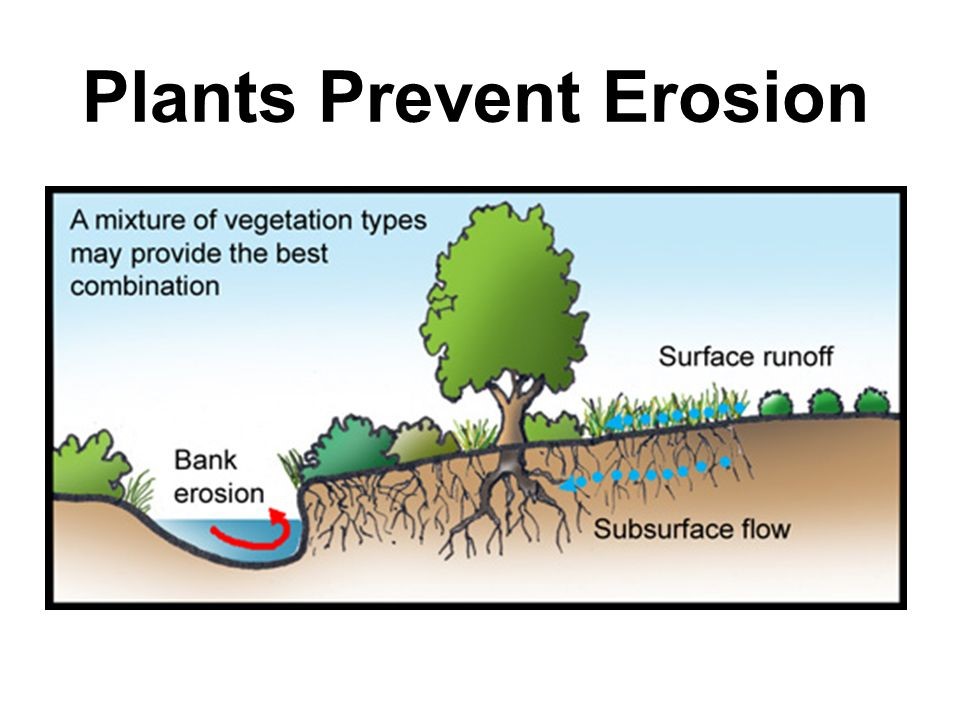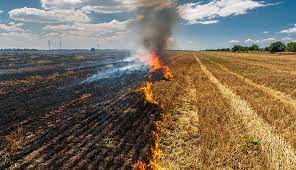Lack of sound farm management and not attending to the cause of resource degradation will reduce the sustainability of the farming enterprise.
Cultivation Methods
By removing all the organic material from the field after harvest - nothing to slow down the flow of water – will ease erosion.
Different Types of Erosion
- Water erosion
- Splash-erosion. The pounding action of raindrops on the surface causes two things; (a) When a raindrop, moving with a speed of about 20 km/h, strikes a bare unprotected area of soil the small soil particles are splattered over a distance due to the weight of the drop and the kinetic energy of the impact on the soil. The thumping action causes the soil surface to seal off, thus reducing and\or preventing the uptake of the water which now increases the volume of runoff water.
- Rill erosion: Rill erosion is the result of runoff water, caused by ‘splash-erosion, which creates small channels from which soil particles are removed and in which other soil particles are transported.
- Gully erosion: Gully erosion is actually the enlargement of rill erosion. In other words, as rill erosion becomes deeper with time, it is known as gully erosion.
- Terracette erosion: This type of erosion normally occurs on steep slopes.
- Streambank erosion: This type of erosion occurs in streams where the banks are widened due to the action of fast-flowing water.
- Tunnel erosion: Tunnel erosion is caused by water making tunnels in the banks of a stream and which collapses with time.
- Wind erosion: The wind moves soil in three different ways.
- Creep: soil roll on the earth’s surface.
- Saultate: where the soil particles bounce into the air and land some distance away.
- Suspension: where the soil is taken up into the moving air and blown away.
Wind erosion causes high soil losses on recently cultivated lands. Soil losses in natural low rainfall areas with skeletal vegetation can also be relatively high.
Factors Affecting Erosion
Rainfall erosion liability: Rainfall erosion liability is the potential of rainfall intensity combined with the kinetic energy of raindrops to cause erosion. Erosion liability will increase in proportion to the intensity of rainfall - the energy generated from runoff water prevents the soil from absorbing water – runoff water ends up in dams or rivers. Soft rain on the other hand allows water to penetrate the soil and is thus of more value to the soil itself.
Soil erosion liability: Soil erosion liability is the loss of soil per rainfall unit. This can be measured by measuring the soil losses from bare runoff plots subjected to natural or simulated rainstorms.
The topography of the soil: The length and steepness of a slope will influence the runoff of water and the erosion accordingly. The steepness of a slope plays a bigger role in erosion than the length of a slope.

Covering: Soil covered with natural vegetation, crops or stubble after harvest is very important to prevent erosion. Economic conditions, intensification of production, drought and poor management can result in the lack of ground covering, leaving the soil bare or with very little vegetative covering to prevent erosion when heavy rains are experienced. Covering is one of the larger factors that contribute to the prevention of erosion. The stubble or mulch covering on land will reduce runoff of rainwater and prevent the seal off (splash erosion) action on the soil which in turn can have a negative effect on water absorption and seed germination.
Management: Management and soil covering is the largest role-playing factors – it can either cause or prevent erosion. An effective management plan of natural veld and croplands can reduce the effect of erosion dramatically. Severely damaged veld\lands must be withdrawn from grazing or any other kind of use for a period of time to allow it to recover naturally or by management inputs such as;
- A structure needs to be put in place to prevent further erosion and the slowdown of runoff rainwater.
- Control stocking rates and initiate proper grazing systems.
- Veld\pastures must be burnt correctly – time and stage.
- Application of veld improvement techniques.
- Correct tillage or cultivation methods and plant density.
- Maintenance of contours and waterways.
Prevention and Control of Erosion

To control erosion there must be a joint action of infrastructure management and natural vegetation management.
To be successful, natural resources must be used and sustained by farming practices in such a way that it should:
- Be in harmony with nature and the ecological factors.
- Not achieve high production at the cost of natural resources.
- And have a sound economic base.
A balance should be reached between soil formation and soil loss. The farmer’s aim should be to reduce soil loss to the minimum to ensure that the soil is kept productive and to save on repair costs to damages caused by erosion.
Farm planning is one of the most essential requirements for successful erosion control. The farm must be planned according to the available natural resources which include:
- Survey
- Assessment
- Planning
- Implementation
- Evaluation
- Maintenance of the infrastructure
Rehabilitation of Damaged Areas and the Establishment of Rehabilitation Areas
To control runoff water the following basic principles need to be identified and applied:
- Natural watershed boundaries are respected
- Natural watercourses are recognised as such and should not be cultivated
- The planning of runoff disposal should start at the highest point in the catchment unless topographic conditions dictate otherwise
- The construction of waterways should begin at the lowest point in the catchment area
Maintenance of Catchments Areas and the Preserving of Rain Water
The catchments area of a dam can spread over very large areas or it can be a small confined area. The effect of water erosion on a dam - soil particles suspended in water is deposited in the dam - the dam loses its water holding capacity because of the build-up of silt on the dam’s surface.
It is very important to ensure good ground covering in the catchment areas and that contour banks and waterways are in order to prevent erosion. These structures must be planned properly and maintained to ensure their correct function
Invasion of Alien Plants
Alien plants such as water hyacinth, black wattle and blue gum trees, as well as bush encroachment (in the bushveld), affects natural resources:
- The water hyacinth spread very easily and can cover large areas of a water system – pollutes the dams and reduce the amount of oxygen in the water.
- The water uptake of black wattle and blue gum trees from the soil is enormous, thus preventing other plants to grow underneath or nearby these trees – resulting in bare spaces where erosion can take place. These alien trees, when growing next to small streams where they use most of the water, can even stop the flowing of water. This again has an effect on the ecosystem. These alien trees must be removed and if necessary be replaced with indigenous trees.
- Busch encroachment –certain trees invade an area and prevent grass from growing amongst them (soil covering) because of strong competition. Because of these bare patches, erosion may occur when heavy rain pours down.
Fire Precautions
Farmers are forced by law to make fire breaks around their property to protect their property against veld fires – spreading from or into neighbour’s veld. It is not always possible to protect the vegetation from accidental burning. In this case, care should be taken to prevent immediate usage when new growth appears. The growing need to be at a certain length before the veld can be lightly grazed. Allow rest periods enabling the grass plant to grow out and to build up reserves for future seed production.
Fire is used as a management tool e.g.
- To encourage the animal to move to different areas - in large game reserves,
- To control bush encroachment.
- To control ticks.
- To burn old grass and provide new growth for the animals.

Sustainable agricultural practices regarding natural resources:
To obtain sustainable use of agricultural- and natural resources, the aim will be to use these resources in a way to ensure that future generations will also be able to produce and enjoy the benefits from these resources. Sustainable use is not only a practice but also an approach to ensure that maximum production can be attained without the detrimental effect on the natural resources and the community.